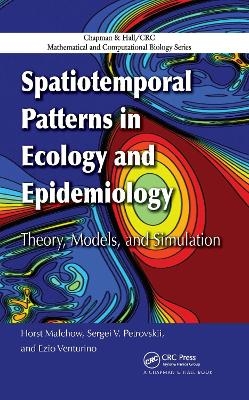
Spatiotemporal Patterns in Ecology and Epidemiology
Theory, Models, and Simulation
Seiten
2019
Chapman & Hall/CRC (Verlag)
978-0-367-38784-6 (ISBN)
Chapman & Hall/CRC (Verlag)
978-0-367-38784-6 (ISBN)
Reviewing the significant progress made in understanding spatiotemporal patterning in ecological and epidemiological systems, this resource shows that mathematical modeling and numerical simulations are effective tools in the study of population ecology and epidemiology. It takes a unified approach to population dynamics and epidemiology by present
Although the spatial dimension of ecosystem dynamics is now widely recognized, the specific mechanisms behind species patterning in space are still poorly understood and the corresponding theoretical framework is underdeveloped. Going beyond the classical Turing scenario of pattern formation, Spatiotemporal Patterns in Ecology and Epidemiology: Theory, Models, and Simulation illustrates how mathematical modeling and numerical simulations can lead to greater understanding of these issues. It takes a unified approach to population dynamics and epidemiology by presenting several ecoepidemiological models where both the basic interspecies interactions of population dynamics and the impact of an infectious disease are explicitly considered.
The book first describes relevant phenomena in ecology and epidemiology, provides examples of pattern formation in natural systems, and summarizes existing modeling approaches. The authors then explore nonspatial models of population dynamics and epidemiology. They present the main scenarios of spatial and spatiotemporal pattern formation in deterministic models of population dynamics. The book also addresses the interaction between deterministic and stochastic processes in ecosystem and epidemic dynamics, discusses the corresponding modeling approaches, and examines how noise and stochasticity affect pattern formation.
Reviewing the significant progress made in understanding spatiotemporal patterning in ecological and epidemiological systems, this resource shows that mathematical modeling and numerical simulations are effective tools in the study of population ecology and epidemiology.
Although the spatial dimension of ecosystem dynamics is now widely recognized, the specific mechanisms behind species patterning in space are still poorly understood and the corresponding theoretical framework is underdeveloped. Going beyond the classical Turing scenario of pattern formation, Spatiotemporal Patterns in Ecology and Epidemiology: Theory, Models, and Simulation illustrates how mathematical modeling and numerical simulations can lead to greater understanding of these issues. It takes a unified approach to population dynamics and epidemiology by presenting several ecoepidemiological models where both the basic interspecies interactions of population dynamics and the impact of an infectious disease are explicitly considered.
The book first describes relevant phenomena in ecology and epidemiology, provides examples of pattern formation in natural systems, and summarizes existing modeling approaches. The authors then explore nonspatial models of population dynamics and epidemiology. They present the main scenarios of spatial and spatiotemporal pattern formation in deterministic models of population dynamics. The book also addresses the interaction between deterministic and stochastic processes in ecosystem and epidemic dynamics, discusses the corresponding modeling approaches, and examines how noise and stochasticity affect pattern formation.
Reviewing the significant progress made in understanding spatiotemporal patterning in ecological and epidemiological systems, this resource shows that mathematical modeling and numerical simulations are effective tools in the study of population ecology and epidemiology.
Malchow, Horst; Petrovskii, Sergei V.; Venturino, Ezio
Introduction. Models of Temporal Dynamics. Spatiotemporal Dynamics and Pattern Formation: Deterministic Approach. Spatiotemporal Patterns and Noise. References. Index.
| Erscheinungsdatum | 01.10.2019 |
|---|---|
| Reihe/Serie | Chapman & Hall/CRC Mathematical Biology Series |
| Sprache | englisch |
| Maße | 156 x 234 mm |
| Gewicht | 870 g |
| Themenwelt | Mathematik / Informatik ► Mathematik ► Angewandte Mathematik |
| Studium ► Querschnittsbereiche ► Epidemiologie / Med. Biometrie | |
| Naturwissenschaften ► Biologie | |
| ISBN-10 | 0-367-38784-0 / 0367387840 |
| ISBN-13 | 978-0-367-38784-6 / 9780367387846 |
| Zustand | Neuware |
| Haben Sie eine Frage zum Produkt? |
Mehr entdecken
aus dem Bereich
aus dem Bereich
ein überfälliges Gespräch zu einer Pandemie, die nicht die letzte …
Buch | Hardcover (2024)
Ullstein Buchverlage
CHF 34,95


